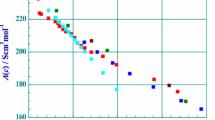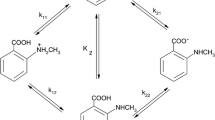Abstract
The electrical conductivities of aqueous solutions of quinic acid and its sodium salt were measured from 293.15 to 328.15 K in steps of 5 K. The molar conductivities of the sodium salt were treated by the Lee–Wheaton equation, in the form of Pethybridge and Taba, and the Kohlrausch equations. The limiting molar conductivities of the quinate anion were estimated, as well as the corresponding ionic association constants and standard thermodynamic functions of the ionic association reaction. The hydrodynamic radius of the quinate anion was calculated from the Walden rule and compared with the van der Waals radius. The dissociation constant of quinic acid was evaluated from the known value of the limiting molar conductivity of quinic acid using the conductivity equation of Pethybridge and Taba. The standard thermodynamic functions of the dissociation process, i.e., the Gibbs energy, enthalpy, entropy and heat capacity, were obtained using the non-empirical procedure given by Clarke and Glew. The standard thermodynamic functions of dissociation of quinic acid are discussed in terms of solute–solvent interactions and stabilization of the quinate anion due to hydrogen bonding of the α-hydroxyl group to the carboxyl group.
Similar content being viewed by others
References
Barco, A., Benetti, S., DeRisi, C., Marchetti, P., Pollini, G.P., Zanirato, V.: D-(−)-quinic acid: a chiron store for natural product synthesis. Tetrahedron-Asymmetry 8, 3515–3545 (1997)
Clifford, M.N.: Chlorogenic acids and other cinnamates—nature, occurrence and dietary burden. J. Sci. Food Agric. 79, 362–372 (1999)
Clifford, M.: What factors determine the intensity of coffee’s sensory attributes? Tea Coffee Trade J. 159, 35–39 (1987)
Allegretti, Y., Ferrer, E.G., Baro, A.C.G.: Oxovanadium(IV) complexes of quinic acid. Synthesis, characterization and potentiometric study. Polyhedron 19, 2613–2619 (2000)
Garribba, E., Lodyga-Chruscinska, E., Sanna, D., Micera, G.: Oxovanadium(IV) binding to ligands containing donor sites. Inorg. Chim. Acta 322, 87–98 (2001)
Inomata, Y., Haneda, T., Howell, F.S.: Characterization and crystal structures of zinc(II) and cadmium(II) complexes with D-(−)-quinic acid. J. Inorg. Biochem. 76, 13–17 (1999)
Castillo-Blum, S.E., Barba-Behrens, N.: Coordination chemistry of some biologically active ligands. Coord. Chem. Rev. 196, 3–30 (2000)
Suryaprakash, P., Kumar, R.P., Prakash, V.: Thermodynamics of interaction of caffeic acid and quinic acid with multisubunit proteins. Int. J. Biol. Macromol. 27, 219–228 (2000)
Gonzalez, C., Carballido, M., Castedo, L.: Synthesis of polyhydroxycyclohexanes and relatives from (−)-quinic acid. J. Org. Chem. 68, 2248–2255 (2003)
Marco-Contelles, J.: Cyclohexane epoxides—chemistry and biochemistry of (+)-cyclophellitol. Eur. J. Org. Chem. 9, 1607–1618 (2001)
Timberlake, C.F.: Complex formation between copper and some organic acids, phenols and phenolic acids occurring in fruit. J. Chem. Soc. 2795–2798 (1959)
Lide, D.R.: In: CRC Handbook of Chemistry and Physics, 76th edn., pp. 5–86. CRC Press, Boca Raton (1995)
Spieweck, F., Bettin, H.: Solid and liquid density determination—review. Technisches Messen 59, 285–292 (1992)
Lee, W.H., Wheaton, R.J.: Conductance of symmetrical, unsimmetrical and mixed electrolytes. J. Chem. Soc. Faraday I 75, 1128–1144 (1979)
Pethybridge, A.D., Taba, S.S.: Precise conductimetric studies on aqueous solutions of 2:2 electrolytes. J. Chem. Soc. Faraday I 76, 368–376 (1980)
Abell, C., Allen, F.H., Bugg, T.D.H., Doyle, M.J., Raithby, P.R.: Structure of (−)-quinic acid. Acta Cryst. C44, 1287–1290 (1988)
Apelblat, A.: An analysis of the conductances of aqueous malonic acid. J. Mol. Liq. 73,74, 49–59 (1997)
Riddick, J.A., Bunger, W.B., Sakano, T.K.: In: Weissberger, A. (ed.) Organic Solvents, Physical Properties and Methods of Purification, 4th edn. Techniques of Chemistry, vol. 2, p. 74. Wiley, New York (1986)
Robinson, R.A., Stokes, R.H.: Electrolyte Solutions, 2nd edn. Dover, New York (2002), p. 465
Archer, D.G., Wang, P.M.: The dielectric-constant of water and Debye–Huckel limiting law slopes. J. Phys. Chem. Ref. Data 19, 371–411 (1990)
Clarke, E.C.W., Glew, D.N.: Evaluation of thermodynamic functions from equilibrium constants. Trans. Faraday Soc. 62, 539–547 (1966)
Barthel, J.M.G., Krienke, H., Kunz, W.: Physical Chemistry of Electrolyte Solutions. Springer, Darmstad (1998), p. 73
Rudan-Tasič, D., Zupec, T., Klofutar, C., Bešter-Rogač, M.: A conductometric study of aqueous solutions of some cyclohexylsulfamates. J. Solution Chem. 34, 631–644 (2005)
Bondi, A.: Van der Waals volumes and radii. J. Phys. Chem. 68, 441–451 (1964)
Edward, T.J.: Molecular volumes and the Stokes–Einstein equation. J. Chem. Educ. 47, 261–270 (1970)
Brummer, S.B., Hills, G.J.: Kinetic of ionic conductance. I. Energies of activation and the constant-volume principle. J. Chem. Soc. Faraday Trans. 5, 1816 (1961)
Rudan-Tasič, D., Klofutar, C., Bešter-Rogač, M.: The electric conductivities of aqueous solutions of rubidium and cesium cyclohexylsulfamates, potassium acesulfame and sodium saccharin. Acta Chim. Slov. 53, 324–330 (2006)
Niazi, M.S.K., Khan, M.Z.I.: Thermodynamic dissociation-constants of salicylic and monochloroacetic acids in mixed-solvent systems from conductance measurements at 25 °C. J. Solution Chem. 22, 437–456 (1993)
Papadopoulos, N., Avranas, A.: Dissociation of salicylic-acid, 2,4-dihydroxybenzoic acids, 2,5-dihydroxybenzoic acids and 2,6-dihydroxybenzoic acids in 1-propanol–water mixtures at 25 °C. J. Solution Chem. 20, 293–300 (1991)
Niazi, M.S.K.: Conductivities and thermodynamic dissociation-constants for chloroacetic acid in binary mixed-solvent systems at 298.15 K. J. Chem. Eng. Data 38, 527–530 (1993)
Apelblat, A.: Dissociation constants and limiting conductances of organic acids in water. J. Mol. Liq. 95, 99–145 (2002)
Portanova, R., Lajunen, L.H.J., Tolazzi, M., Piispanen, J.: Critical evaluation of stability constants for α-hydroxycarboxylic acid complexes with proton and metal ions and the accompanying enthalpy changes. Part II. Aliphatic 2-hydroxycarboxylic acids. Pure Appl. Chem. 75, 495–540 (2003)
Christensen, J.J., Smith, D.E., Slade, M.D., Izatt, R.M.: Thermodynamics of proton ionization in dilute aqueous solution 16. ΔG° (pK), ΔH°, ΔS° and ΔC p° values from several cycloalkanecarboxylic acids 10, 25 and 40°. Thermochim. Acta 4, 17–24 (1972)
Hepler, J.L., O’Hara, W.F.: Thermodynamic theory of acid dissociation of methyl-substituted phenols in aqueous solution. J. Phys. Chem. 65, 811–814 (1961)
Pitzer, K.S.: The heat of ionization of water, ammonium hydroxide and carbonic, phosphoric and sulfuric acids. The variation of ionization constants with temperature and entropy change with ionization. J. Am. Chem. Soc. 51, 2365–2379 (1937)
Author information
Authors and Affiliations
Corresponding author
Rights and permissions
About this article
Cite this article
Klofutar, C., Šegatin, N. Electrical Conductivity Studies of Quinic Acid and its Sodium Salt in Aqueous Solutions. J Solution Chem 36, 879–889 (2007). https://doi.org/10.1007/s10953-007-9154-1
Received:
Accepted:
Published:
Issue Date:
DOI: https://doi.org/10.1007/s10953-007-9154-1




